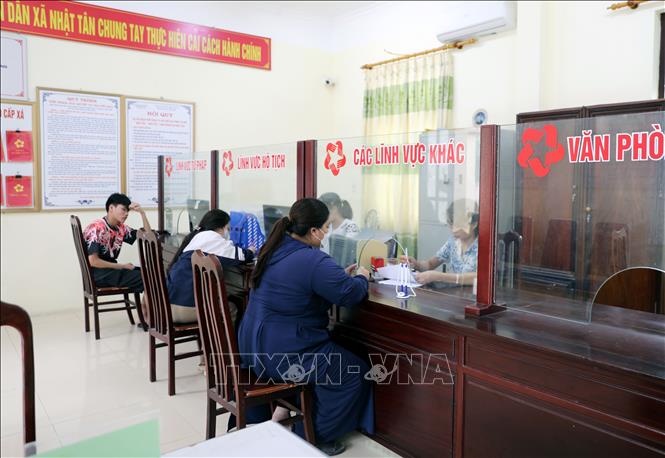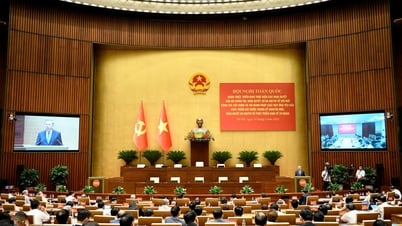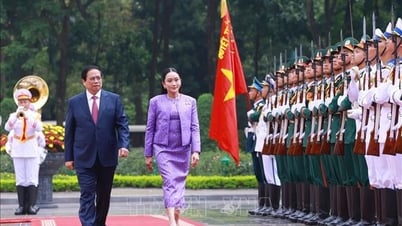
The ultimate goal of the provincial merger is to create development space for new administrative units in line with the National Master Plan for the 2021-2030 period, with a vision to 2050. Illustrative photo: VNA
Previously, on April 12, Resolution No. 60-NQ/TW of the 11th Central Conference, Session XIII, decided that the number of provincial-level administrative units after the merger is 34 provinces and cities (28 provinces and 6 centrally-run cities); the names and political -administrative centers of provincial-level administrative units after the arrangement are determined according to the principles stated in the Submission and Project of the Government Party Committee; merging commune-level administrative units ensures that the whole country reduces the number of commune-level administrative units by about 60-70% compared to the present.
According to the Project on rearranging and reorganizing administrative units at all levels and building a 2-level local government organization model, there are 11 provincial-level administrative units that will not be merged, including Hanoi city, Hue city and the provinces of Lai Chau, Dien Bien, Son La, Lang Son, Quang Ninh, Thanh Hoa, Nghe An, Ha Tinh, Cao Bang. The remaining 52 provincial-level administrative units will be merged and consolidated into 23 new provincial-level administrative units.
The ultimate goal of provincial mergers is to create development space for new administrative units in accordance with the National Master Plan for the 2021-2030 period, with a vision to 2050.
After nearly 40 years of innovation, the current situation of organizing the country's development space still has many limitations - the development space is fragmented according to administrative boundaries; regional linkages still have many shortcomings; development investment is still scattered without concentrating resources to clearly form dynamic regions that play a leading role and lead the country's economic growth; a synchronous and modern national infrastructure framework has not been formed...
The main causes of the above situation are the scattered development thinking, lacking focus and key points; lack of overall national planning to clearly define the development model according to the territorial space nationwide; lack of mechanisms and policies to promote inter-sectoral and inter-regional economic development; and still having local ideology.
This merger of provincial administrative units is a step towards effectively organizing the national development space, achieving intra-regional and inter-regional connectivity and exploiting the comparative advantages of each region, enhancing national competitiveness.
The merger of provincial administrative units is also a step to carry out focused and key development, focusing on a number of areas with favorable conditions in terms of geographical location, economic and social infrastructure, high-quality human resources and other potentials and advantages for development to form dynamic regions, economic corridors, growth poles, creating a spillover effect to promote the rapid, effective and sustainable development of the whole country's economy; at the same time, there are mechanisms, policies and resources suitable to the conditions of the economy to ensure social security for disadvantaged areas, gradually narrowing the gap between regions.
The merger of provincial administrative units also aims to effectively and economically use resources, especially land resources, water resources, forest resources and minerals of the Fatherland.
The merger of provincial administrative units also aims to organize national development space to link land areas with sea spaces; exploit and effectively use underground spaces, sea areas, and airspace; focus on connecting domestic economic corridors with regional and international economic corridors; closely combine economic, cultural, and social development with ensuring national defense and security.
Currently, only 28 out of 63 provinces and cities have sea, so the merger is to create conditions to expand access to the sea space - a space of strategic significance in terms of economy, defense and long-term development.
The merger and consolidation of one province with another is carefully considered and weighed, taking into account many factors to achieve sustainable and long-term development.
For example, the process of merging Thai Binh and Hung Yen into the new province of Hung Yen is not a story of "who encroaches on who" but rather "unite strength for development".
After the merger, the new Hung Yen province has a natural area of over 2,500 km² (double the size of the old Hung Yen province) and a population of over 3 million people (including 1.2 million people from Hung Yen and 1.8 million people from Thai Binh). This is the basis for forming a large domestic market, creating advantages in scale for manufacturing and service industries. The removal of administrative boundaries between the two provinces will promote the free flow of capital, labor and technology, thereby optimizing existing resources.
Experts believe that the merger of Hung Yen and Thai Binh will turn two separate “pieces” into a unified entity, creating a new economic space. Hung Yen’s industrial parks can connect directly with the abundant labor force from Thai Binh, while Thai Binh’s agricultural products can find stable outlets through Hung Yen’s logistics system. We can expect a leading development center of the Red River Delta in the future.
The fact that 11 provincial administrative units are not included in the complete merger is not a matter of "who favors whom" but depends on factors of population, area, geography, economy, history and culture.
For example, the two provinces of Nghe An and Thanh Hoa in the North Central region, although standing alone, still have great potential and internal advantages, and can be considered a "miniature Vietnam" with diverse terrain - mountains, plains, sea, borders, airports, seaports, and highways.
The naming of the new administrative unit was also thoroughly researched, carefully considering traditional, historical and cultural factors; prioritizing the use of one of the names of the provinces before the merger to name the new province, minimizing the impact on people and businesses due to the conversion of documents, geographical indications, etc.
The story of placing the administrative-political center of the new administrative unit also made many people "think". Someone expressed his opinion: If "I" lose my name, in return, "you" must give up the provincial capital (!).
However, the location of the new provincial center must follow clear criteria: favorable geographical location, synchronous economic and social infrastructure, especially a developed transportation system (airport, road, port, ...), easy connection with areas within the province, cities and large urban areas, economic centers of the country or with the marine space system.
The administrative-political center of the new administrative unit must have space for future development; be consistent with the socio-economic development orientation of the new administrative unit, ensure harmony and rationality, avoid imbalance between localities when merging and maintain national defense and security.
Moreover, the idea of expanding development space has made a breakthrough when each new province will not only have an administrative-political center, where the headquarters of local agencies are located, but will also have the opportunity to develop additional economic centers, cultural centers, tourist centers, etc. from the merged provinces.
We must deeply realize that the rearrangement of provinces and cities is to create space for a hundred-year development strategy not only for localities but also towards the highest goal of the common development of the country with one hundred million people.
The thought of “losing the name of the province” and “being far from the provincial capital” is a common human emotion. However, the national vision and the highest interests of the country must be placed above all those “local” thoughts!
Tran Quang Vinh (Vietnam News Agency)
Source: https://baotintuc.vn/thoi-su/tinh-gon-bo-may-tam-nhin-quoc-gia-dat-tren-tam-tu-tinh-nha-20250415090030462.htm



![[Photo] General Secretary To Lam visits exhibition of achievements in private economic development](https://vphoto.vietnam.vn/thumb/1200x675/vietnam/resource/IMAGE/2025/5/18/1809dc545f214a86911fe2d2d0fde2e8)

![[Photo] National conference to disseminate and implement Resolution No. 66-NQ/TW and Resolution No. 68-NQ/TW of the Politburo](https://vphoto.vietnam.vn/thumb/1200x675/vietnam/resource/IMAGE/2025/5/18/adf666b9303a4213998b395b05234b6a)

![[Photo] More than 17,000 candidates participate in the 2025 SPT Competency Assessment Test of Hanoi National University of Education](https://vphoto.vietnam.vn/thumb/1200x675/vietnam/resource/IMAGE/2025/5/17/e538d9a1636c407cbb211b314e6303fd)

























































































Comment (0)